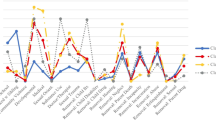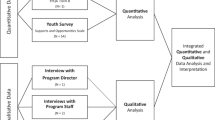Abstract
One approach that is useful for improving services to a heterogeneous population is to develop typologies of the subgroups within the population. Over the last few years there have been a number of typologies put forward to better define those youths who run from home. However, these typologies historically have been based on practice experience and literature reviews. In this paper, the literature is reviewed to develop composite groups of runaways and homeless youths. Then this proposed typology is tested with a sample of 262 youths from runaway shelters and youths “living on the street.” Discriminate analysis is used to develop an empirically based typology. Implications for clinicians and service providers are discussed.
Similar content being viewed by others
References
Adams-Tucker, C. (1982). Proximate effects of sexual abuse in childhood: A report on 28 children.American Journal of Psychiatry, 3, 139:10
Ambrosino, L. (1971).Runaways, Boston: Beacon Publishing
Brennan, T. (1980). Mapping the diversity among runaways.Journal of Family Issues, 1, 189–209.
Cherry, A. L. (1986). “The Social Bond: A beginning discourse.” Graduate School of Social Work, Marywood College, Scranton, Pa. (Unpublished manuscript).
Cherry, A. L., (1987). “Social Bond theory and alcohol use among college students.Journal of College Student Personnel, March, 128–135.
—, (1990).The magnitude and nature of homelessness in South Florida: A yearlong study of homeless people in shelters and on the street 1988/1989. Barry Univ. School of Social Work, Miami Shores, FL.
Edelbrock, C. (1980). Running away from home.Journal of Family Issues, 1, 2, 210–228.
English, C. J. (1973). Leaving home: A typology of runaways.Society, (July–August), 10, 22–24.
Gullotta, T. P. (1978). Runaway: Reality or myth.Adolescence, 13, 543–549.
Janus, M. D., McCormick, A., Burgess, A. M. & Hartman, C. (1987).Adolescent Runaways: Causes and Consequences. Mass: Lexington Books.
Jones, L. P. (1988). A typology of adolescent runaways.Child and Adolescent Social Work, 1, 5, 16–29.
Mills, C., & Ota, H. (1989). Homeless women with minor children in the Detroit metropolitan area.Social Work, 34, 6, 485–489.
Orten, J. D., & Soll, S. K. (1980). Runaway children and their families: A treatment typology.Journal of Family Issues, 1, 2, 249–261.
Ravoira, L. (1990).Social Bond and Teen Pregnancy: A Comparison of Pregnant and Parenting Teenagers and Never Pregnant Teenagers who Sought Services from Four Homeless Shelters. Nova University. Doctoral Dissertation.
Roberts, A. R. (1982). Adolescent Runaways in suburbia: A New Typology.Adolescence. 17:387–396.
Shane, P. G. (1989). Changing patterns among homeless and runaway youth.American Journal of Orthopsychiatry, 59, 2, 208–214.
Shellow, R., Schamp, J., Liebow, E., & Unger, E. (1967). Suburban runaways of the 1960's.Monographs of the Society for Research in Child Development, 32.
SPSS Inc. (1986).SPSSx user's guide. 2nd ed.. SPSS Inc., Chicago.
Weinberg, D. K. (1985).Children of the Night: A Study of Adolescent Prostitution. Mass: Lexington Books.
Zide, M. R. (1990).Social Bonds: A childhood lost — Runaway, Thrown out and Forsaken Youth. Barry University. Doctoral Dissertation.
Author information
Authors and Affiliations
Rights and permissions
About this article
Cite this article
Zide, M.R., Cherry, A.L. A typology of runaway youths: An empirically based definition. Child Adolesc Soc Work J 9, 155–168 (1992). https://doi.org/10.1007/BF00755230
Issue Date:
DOI: https://doi.org/10.1007/BF00755230




